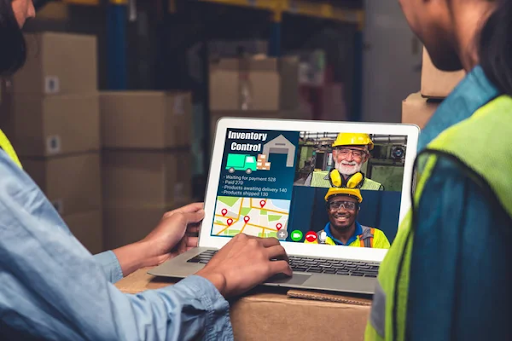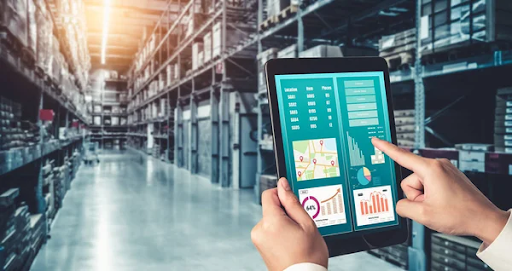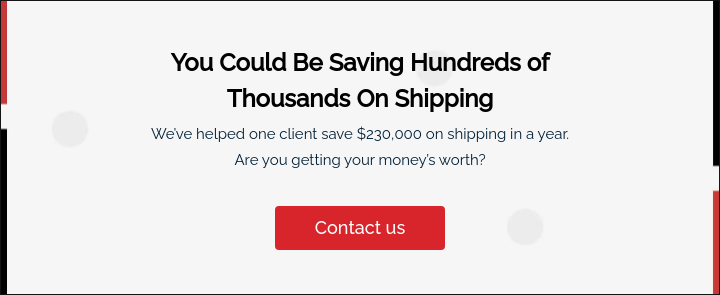How to Choose a 3PL Warehouse Management System
Online shopping benefits customers and retailers alike. Customers can shop for many items quickly and retailers can reach a broad market. However, customers want deliveries almost as fast as they shop. You can’t let logistical hiccups slow your shipments. A 3PL warehouse management system (WMS) can increase your warehouse productivity and cut bottlenecks.
With a WMS, it’s easy to automate tedious manual tasks and remotely supervise your warehouse staff to keep everything running smoothly.
Like any software, you need to do your research to ensure that you’re choosing the best 3PL software for your business. So, this article will highlight 9 things to look for when selecting the right 3PL warehousing management tool. We’ll also examine what it is and how it helps.
What Is a 3PL Warehouse Management System?
A WMS is a software tool that lets you track your warehouse management tasks. Warehouse management software features may include:
- Inventory management
- Location management
- Order management
- Work creation and scheduling
- Process detailing for pick, pack, and ship
- Productivity reports and analytics
Comparatively, 3PL warehouse management software is a WMS for 3PL fulfillment. It’s a much better software solution for enterprises with multiple warehouses. Many traditional WMS tools are made for single warehouse operations and can’t handle 3PL.
While most 3PL warehouse software tools aren’t strikingly different from their traditional counterparts, a high-quality 3PL WMS system should offer the following capabilities.
3PL Billing
Whether you’re a 3PL business yourself or working with multiple providers, billing multiple entities gets complicated fast. Opt for a 3PL warehouse management software that can consolidate all your transactions into one report.
Transparent Inventory Tracking
Real-time inventory tracking benefits 3PL businesses and their clients. 3PL companies must constantly track their freight shippers, which is simple if your software can follow the location of goods. It also helps warehouses make informed inventory decisions. Customers also appreciate consistent updates about the status of their orders.
Order Fulfillment Features
Part of the reason why warehouses hire 3PL partners is to offload the burden of order fulfillment. Good 3PL warehouse management systems play this role for 3PL providers. They streamline order fulfillment procedures to cut tedious tasks down to size.
Multi-System Support
Your 3PL warehouse management tool should be able to integrate with everything your partners or providers use. If not, you may limit visibility and increase siloing between the warehouse and 3PL partner.
Before You Start Looking…
3PL management software solutions can simplify your day-to-day. Still, you shouldn’t just get one just for the sake of getting one. Have a strategic plan that highlights your business goals and how a WMS will help you meet them.
Here are some questions you can ask yourself before you seek 3PL WMS vendors.
- What problems are you hoping to solve?
- What are you doing now that a WMS will improve?
- How many partners do you work with?
- What challenges do you foresee in the future?
- Does your business ship any specialty products that need extra regulation?
- What is your typical order volume? When are your peak seasons?
- How much work can your team handle manually?
- What is your budget? How can you get the best quality for your buck?
- Do you offer international shipping?
- How many users do you anticipate?
- How important is fast shipping to your business?
Once you’ve considered these questions, start shopping for vendors. The answers to these questions will help you narrow down a WMS shortlist and help you prioritize features.
Every WMS is different, but you should always watch for the following 9 features.
What to Look for in a 3PL Warehouse Manager Software
1. Scalability
When a business works with a third-party logistics partner, it’s probably because they’re too large to handle all of their orders on their own. Once a company starts growing, they rarely slow down. So, opt for a 3PL logistics management software tool that can scale with rapid growth.
During the pandemic, many eCommerce companies experienced exponential growth, and this trend is continuing. By the end of 2023, American eCommerce sales are expected to hit $8.1 trillion USD.
It’s a good idea for eCommerce companies to prepare for rapid growth even if they haven’t experienced it yet. A 3PL partnership and scalable tool are ways they can prepare.
2. Automation
Backlogs happen fast when you’re dealing with a high volume of orders. Warehouse operators are quickly overwhelmed by sudden spikes and this can slow down your order fulfillment. These backlogs are especially concerning during timely peak seasons like the holidays.
 Credit: BiancoBlue
Credit: BiancoBlue
Prevent bottlenecks with a third-party logistics and warehouse software solution that has easy-to-use automation features. These features should let you quickly set rules about which orders are prioritized, and how they get boxed and shipped.
Use these rules to make sure presents arrive on-time, food doesn’t expire en-route, and employees save time on fulfillment.
3. Online Capabilities
People may use your 3PL warehouse software on the road or from offsite locations. Your data needs to stay consistent for all viewers to prevent miscommunication. A cloud-based WMS solves this issue. Anyone with an internet connection sees the same data.
Consistency isn’t the only advantage of a web-based WMS. A cloud-based WMS is generally more scalable, secure, and has faster processing power. The cloud also makes your WMS run 24/7. This is perfect for eCommerce providers because online shoppers can order anytime.
4. Transportation Management
Some warehouse management tools also function as a transportation management system (TMS). A solution that can do both is particularly important for a 3PL system because 3PL companies need to keep a close eye on their logistics.
Transportation management optimizes how your shipments move and ensures that truckers have the documentation they need to make a delivery. This system promotes timely deliveries and offers greater shipment transparency.
If you’re delivering across borders, this feature becomes even more important. Organize the necessary paperwork in your system so that drivers can access it in seconds, minimizing the chance that they’ll get “stuck at the border.”
5. Current Technology
Outdated technology is less secure, slower, and more error-prone. 3PL warehouse management systems included. Seek modern solutions that stay up-to-date with technology and logistics industry trends.
You also want a solution that integrates with multiple environments. Outdated software is less compatible with newer IT systems. This can quickly cause headaches for your partners when they want to use your system.
6. Integrations
For best results, seek a WMS that integrates with other tools you use. Many systems will automatically pull information from your other tools to streamline operations. Some useful integrations are:
- CRMs: Customer data from your CRM lets you track customer activity throughout your order fulfillment process.
- ERPs: Integrating your WMS with your ERP prevents data repetition and silos.
- TMSs: if you have a separate TMS, it’s crucial for your WMS users to be able to see TMS data.
- BI: Analytics from your WMS reporting should feed into your business intelligence (BI) tool to help your accounting team create consolidated reports. (For reference, business intelligence tools are a great way to collect data you’re able to tap into with inquiries.)
- eCommerce platforms: An eCommerce platform integration lets your WMS know that there’s a new order the moment a shopper makes a purchase.
You might also want to look for a system that can integrate with a custom in-house software tool. Anything that holds valuable information for your warehouse or 3PL partner should integrate with your WMS.

7. Label Compliance
Label compliance is essential for any company that offers international shipping. Improper labeling can cause unnecessary shipping costs at best and unfulfilled orders at worst.
A high-quality WMS tracks different label requirements for every country you ship to. Standardized labeling reduces the risk of human error and keeps you consistently in compliance.
8. User Friendliness
Don’t underestimate the importance of a user-friendly design. User-unfriendly WMS systems have less user adoption, hurt productivity, and even affect employee morale. If people are frustrated with your technology system, it can grow into frustration with your company.
Your WMS should make operations easier. Poor user design defeats this purpose and can be more inefficient than not having one at all. This is because finding workarounds can be more time-consuming than well-known manual processes.
9. Added Services
Warehouse management tools can also have additional unique features. These features fit well with niche businesses. You may or may not seek any of these added services. Depending on your business goals, you might want a 3PL warehouse management software that offers:
Specialty Materials Support
Some products like medicine, hazardous goods, or live animals need comparatively more attention. Regular tracking and compliance measures may not be sufficient for certain specialty products.
For example, if your products cannot be left unattended, you’ll need inventory tracking that also measures whether a worker is present. Label compliance may also differ for highly regulated products.
Kitting Features
Kitting is a great way to add a personal touch while streamlining product shipments. It’s ideal for companies that sell subscription boxes and boosts brand awareness.
WMS kitting functionality standardizes your warehouse’s kitting process. It makes it easy to consolidate multiple SKUs into one and may track which SKUs go well together.
Food Recall Tools
If you sell any food items, there are strict recall protocols in place when it comes to storage and shipping. Failing to adhere to them can have legal ramifications for your business. Some WMS tools include a food recall feature that makes this process as simple and prompt as possible anytime it's necessary.

Exception Management
Some WMSs have an exception management module. This module will flag atypical orders so you know to give them extra attention or move them out of your processing lane. These situations could be due to weight, size, or a customer’s special request.
Support for High-Volume Returns
No business likes to think about order returns, but they happen and you need to be ready for them. eCommerce businesses should prepare for a high volume of returns simply because of the number of orders they process. If you send a lot of shipments, make sure your WMS can handle a lot of returns.
Entrust Your 3PL Warehouse Management Systems to the Fulfillment Lab
There’s no doubt that 3PL warehouse management software simplifies your shipping process. Yet, even with the right tools for the job, you need someone who knows how to use them. Improper usage can be just as much of a headache as the wrong software.
When you work with The Fulfillment Lab, you can leverage the benefits of a sophisticated warehousing system that lets you personalize SKUs and target customer journeys effectively.
Schedule a meeting with a fulfillment expert.




